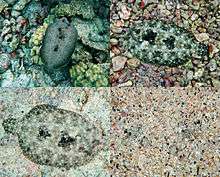Flower mantis
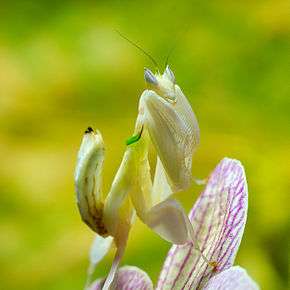
Flower mantises are those species of praying mantis that mimic flowers.[1] Their coloration is an example of aggressive mimicry, a form of camouflage in which a predator's colours and patterns lure prey.[2] Most species of flower mantis are in the family Hymenopodidae. Their behaviour varies, but typically involves climbing a plant until they reach a suitable flower, and then staying still until a prey insect comes within range. Many of these mantises have deimatic displays to startle or put off potential predators.
Many species of flower mantis are popular as pets.
Behaviour
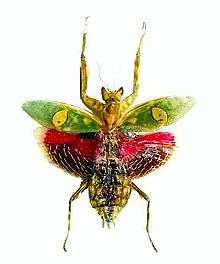
The orchid mantis, Hymenopus coronatus, of southeast Asia mimics a pink orchid flower. It remains motionless on the flower spike until prey arrive; the same camouflage also protects it from predators.[3] In his 1940 book Adaptive Coloration in Animals, Hugh Cott quotes an account by Nelson Annandale, saying that the mantis hunts on the flowers of the "Straits Rhododendron", Melastoma polyanthum. The nymph has what Cott calls "Special Alluring Coloration" (aggressive mimicry), where the animal itself is the "decoy". The insect is pink and white, with flattened limbs with "that semi-opalescent, semi-crystalline appearance that is caused in flower-petals by a purely structural arrangement of liquid globules or empty cells". The mantis climbs up and down the twigs of the plant until it finds one that has flowers. It holds on to these with the claws of its two rearmost pairs of legs. It then sways from side to side, and soon various small flies land on and around it, attracted by the small black spot on the end of its abdomen which resembles a fly. When a larger dipteran fly, as big as a house fly, landed nearby, the mantis at once seized and ate it.[4][5] More recently (2015), the orchid mantis's coloration has been shown to be an effective mimic of tropical flowers; and it has been demonstrated to attract pollinators (as if it were a flower) and then to catch them.[6]
Example species
The flower mantises include the following species, many of which are popularly kept as pets:
| Species | Common names | Image | Distribution | Notes |
|---|---|---|---|---|
| Acromantis formosana | Taiwan flower mantis[7] | |
Taiwan | Nymphs are dark brown, flanged and spined, highly cryptic on dead leaves. Adults have green wings. |
| Blepharopsis mendica | Small devil's flower mantis[8] Devil's flower mantis Thistle mantis[9] Egyptian flower mantis Arab mantis[10] |
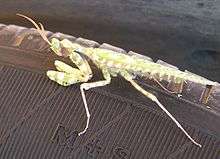 |
North Africa, Canary Islands | Deimatic display with head and thorax rotated to one side. |
| Chloroharpax modesta | Nigerian flower mantis[11] | |
West Africa | Adult female has ocellated eyespots on wings. Aggressively hunts prey larger than itself. |
| Creobroter gemmatus and other species in genus Creobroter |
(Flower mantises) | _from_W-Java_%E2%99%80.jpg) |
South and Southeast Asia | Fly strongly on long wings. Eyespots on forewings, varying colours. Deimatic display of bright hindwings. |
| Gongylus gongylodes | Wandering violin mantis Ornate mantis Indian rose mantis[12] |
|
South Asia | Up to 11 cm; males can fly. |
| Hymenopus coronatus | Orchid mantis[3] Walking flower mantis[13] |
 |
Southeast Asia | Hunts flies on "Straits Rhododendron", Melastoma polyanthum. |
| Idolomantis diabolica | [Giant] devil's flower mantis[14][15] |  |
Central and East Africa | Large insect, females as much as 13 cm. Brightly coloured deimatic display in red, white, blue, purple and black. |
| Parymenopus davisoni | Yellow flower mantis,[16] Davison's mantis |
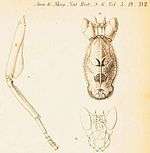 |
Southeast Asia | A slender yellow mantis, the female with three dark spots on the wings. |
| Pseudoharpax virescens | Gambian spotted-eye flower mantis[17] |  |
East, Central and West Africa | Adult female has eye spots on abdomen. |
| Pseudocreobotra wahlbergii | Spiny flower mantis Bulls-eye mantis #9 Mantis[18] |
 |
South and East Africa | Effective aggressive mimic of flower; can handle prey much larger than itself. Deimatic display with spread wings to show off "number 9" eyespots. Variable coloration. |
| Pseudocreobotra ocellata | Spiny flower mantis Spiny flower praying mantis African ocellated mantis[19][20] |
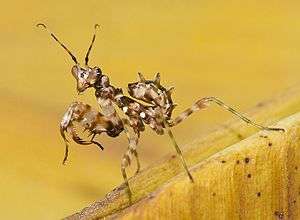 |
West, Central and Southern Africa | Like P. wahlbergii. |
| Theopropus elegans | Banded flower mantis Asian boxer mantis[21] |
 |
Southeast Asia | White stripe on forewings. Colours can vary. |
See also
References
- ↑ www.environmentalgraffiti.com: 15 Incredible Flower Praying Mantis Pictures
- ↑ Wickler, 1968.
- 1 2 Gullan and Cranston, 2010. p 370.
- ↑ Cott, 1940. pp392-393.
- ↑ Annandale, Nelson (1900). "Notes on the Habits and natural Surroundings of Insects made during the 'Skeat Expedition' to the Malay Peninsula, 1899–1900". Proceedings of the Zoological Society of London: 837–868.
- ↑ Choi, Charles Q. (30 November 2013). "Found! First Known Predator To Lure Prey By Mimicking Flowers". LiveScience. Retrieved 2 July 2015.
the color of the orchid mantis was indistinguishable from 13 species of wild flowers in the areas the predator lived. ... The orchid mantis is unique in that the mantis itself is the attractive stimulus.
- ↑ USA Mantis: Acromantis formosana
- ↑ Keeping Insects: Blepharopsis mendica
- ↑ Insectstore, mantis caresheets: Blepharopsis mendica
- ↑ Dannesdjur: image gallery: Blepharopsis mendica
- ↑ USA Mantis: photos of Chloroharpax modesta
- ↑ Cott, 1940. p336.
- ↑ Dorai, Francis (ed.) (2011). Singapore at Random. Editions Didier Millet. p. 18.
- ↑ Insect Store: Idolomantis diabolica
- ↑ Reptileforums: Idolomantis diabolica
- ↑ Reocities.com: Parhymenopus davisoni
- ↑ Keeping Insects: Pseudoharpax virescens
- ↑ MantisKingdom: Caresheet of Pseudocreobotra wahlbergii
- ↑ Exotic Pets: Spiny Flower Mantis
- ↑ PetBugs.com: Caresheet on P. ocellata
- ↑ USA Mantis logs: Theopropus elegans
Bibliography
- Cott, Hugh B. (1940). Adaptive Coloration in Animals. Methuen, London.
- Gullan, PJ; Cranston, PS (2010). The Insects: An Outline of Entomology. Wiley (4th edition).
- Wickler, Wolfgang (1968). Mimicry in plants and animals. McGraw-Hill, New York.
